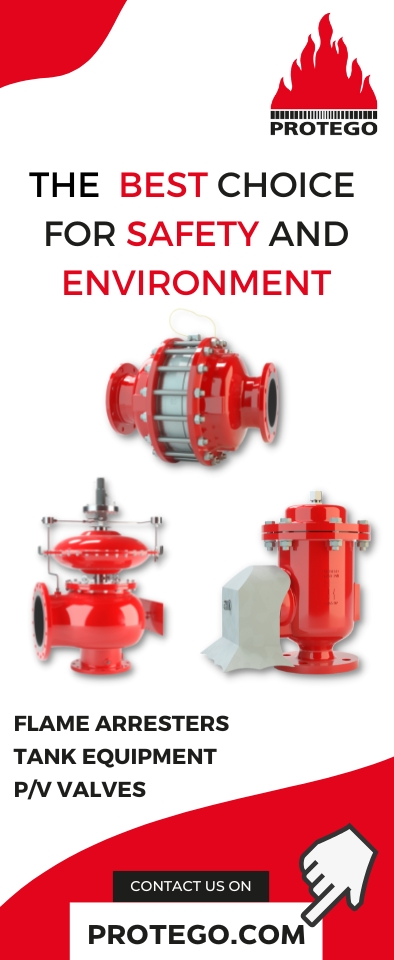José Miguel González, Tecam’s engineering director, explains why terminals should be making the most of their waste
Dozens of barges, hundreds of trucks and thousands of gallons of valuable products are stored in tanks at a terminal. Terminal operators have enough parameters to organise and pay attention to, so that the terminal and consequently the business run efficiently and optimised. And all of course under highly safe and environmentally friendly requirements. It is not a small deal of work that is being managed.
An external observer could say that a tank terminal is like a big black box with a certain number of inputs and outputs. The valuable materials come in, they are stored and they come out as per the demands of the market. Utilities are necessary for the correct operation of the terminal. In principle, the sum of inputs should be equal to sum of outputs. However, it doesn’t always work exactly like that. There are product losses, emissions losses and different types of waste that are generated regularly.
So, what if waste at a terminal could be considered efficient and valuable?
There are highly reliable and efficient technology solutions which are compliant with best available techniques. These can help terminals minimise the quantity of invaluable outputs. Most terminals already have an optimised system to treat and recover liquid waste: drainage of tanks, spills, oily water coming from rainfalls, even contaminated water. These are gallons of liquid that can be treated at a terminals wastewater treatment plant (WWTP), and many are achieving high rates of efficiency and recovery of that valuable material. However, there are two other types of waste from which terminals still have significant options to recover and increase their value.
All The Waste You Cannot See
It is common practice nowadays that tanks, pipes, rotating equipment, valves, and any other process units or elements are designed and adequately maintained so that diffused emissions are minimised if not completely avoided. In addition, there are other emissions that are subject to a different approach, which is to channel them so that they are collected and treated onto process units. The process units’ purpose should be: firstly, to recover valuable material and, secondly, to minimise emissions of pollutants to atmosphere and comply, with the corresponding environmental legislation, policies and specific authorisations accordingly. Those channelled emissions are usually related to operations of filling and emptying tanks, breathing, cleaning, draining, purging, connecting, disconnecting, etc.
In many cases, gaseous emissions from these operations contain vapours composed of the valuable material that is being stored. Terminal operators do not need to issue them into the atmosphere and loose substantial mass of the stored product. Vapour recovery units, which are based on adsorption and desorption chemical process, can help companies recover up to 99% of gaseous molecules of valuable product at your plant, especially during highly inefficient activities at the plant, such as loading and offloading of trucks.
Sludge Waste
Another kind of residue generated at tank terminals is sludge. This typically forms on the tank bottom and is revealed during the cleaning process. Derived from hydrocarbon or chemical substances that are left behind, the sludge can be treated in a rotary kiln, with possible energy production output.
Daily Waste
Most terminals will have several bins and containers to duly dispose different types of solid waste generated on a daily basis. All these wastes, especially those with certain chemical properties, and/or high low heating value, are valuable as long as you can manage them adequately. A small to medium sized waste-to- energy or waste-to-product plant could be installed at a terminal, to obtain substantial benefits. If not, other companies could be making business from this waste, by recycling it or converting them onto something valuable. It can be steam production, electricity production, or even the production of highly valuable raw materials, such as pyrolysis oil (the basis to manufacture plastic or biofuels). From small units treating waste in batches, at rates of 100-200 kg/h during normal working hours, to bigger plants with capacity to treat on a continuous basis from 250 to 5,000 kg/h.
Sitting On A Profit
Managing a terminal will have an additional advantage when compared to others if an operator is benefiting from its waste. Usually, the initial investment that is required for a waste valorisation plant is composed approximately of a first package of costs of 50-70% in terms of new process, mechanical and electrical equipment. The second package of the investment would correspond to earthworks, foundations, paving and roads, building offices, fencing, etc. The payback period would be between five and ten years, depending on each case. A tank terminal would have to pay, in general terms, for the first package only, making the period of payback substantially shorter. In fact, since it is 100% sure that waste at a plant can be converted into a profitable output, why keep on wasting all this waste?
















